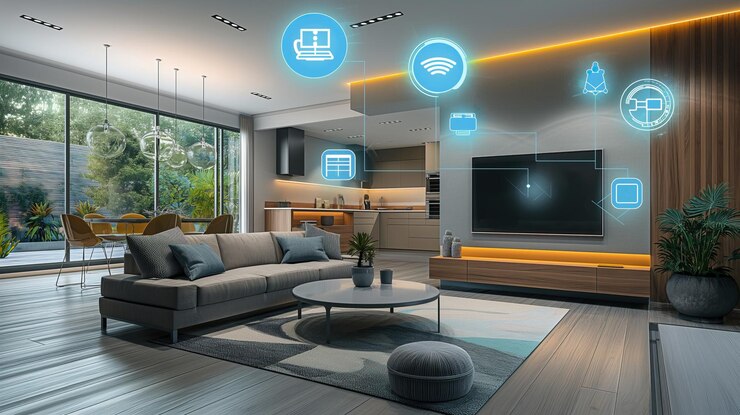In a world saturated with notifications, screen time, and digital noise, there’s a growing desire to tune out the chaos. Enter: Calm Technology. Originally conceptualized by Mark Weiser and John Seely Brown in the late 1990s, calm tech focuses on designing technology that informs without overwhelming—tech that blends seamlessly into our lives instead of demanding our constant attention. Discover how calm tech is quietly transforming digital interfaces and home design. Explore the rise of non-intrusive tech that blends into our lives with elegance and purpose.
Fast forward to 2025, and this philosophy is no longer an academic concept. It’s actively shaping how we design both our digital experiences and our physical spaces. From the apps we use to the lighting in our living rooms, Calm Technology is becoming the gold standard for modern, human-centered design.
What Is Calm Tech, Really?
Calm Tech is based on one central idea: the most advanced technologies should require the least attention. It embraces the notion that technology can be powerful yet invisible, informative but not disruptive.
Key principles of Calm Tech include:
- Technology should amplify the periphery of our attention, not dominate it.
- It should empower the user, not distract them.
- It should respect context and human presence.
The goal? A more peaceful, ambient relationship with our tools, where they quietly support our lives without stealing focus.
Calm Tech in the Smart Home
The rise of smart homes has created an ideal testing ground for Calm Technology. Consumers don’t want a home filled with flashing lights, beeping gadgets, or constant updates. They want serenity—with just the right touch of automation.
Here’s how calm tech principles are being woven into modern home design:
Ambient Lighting and Climate Control
Instead of toggling thermostats or fidgeting with apps, modern smart systems like Nest, Ecobee, and Philips Hue use motion sensors and learned behavior to automatically adjust lighting and temperature. The experience feels intuitive rather than managed.
Subtle Notifications
Amazon Echo and Google Nest devices now feature visual light cues (rings, glows) instead of constant audio notifications. Smart doorbells like Ring use vibration and soft chimes to alert, rather than loud buzzers.
Furniture with Integrated Tech
Companies like IKEA are embedding Qi wireless charging pads into tables and desks. These invisible integrations allow tech to blend into everyday life, not stand apart.
Voice Assistants That Listen, Not Interrupt
Modern AI assistants are being trained to avoid interjecting unless prompted. Features like Apple’s ambient Siri or Samsung’s Bixby routines are designed to quietly adapt rather than intrude.
User Interfaces: From Obsessive to Obedient
Our relationship with screens is evolving. While attention-grabbing UIs dominated the 2010s, the 2020s are all about restraint. Here’s how Calm Tech is transforming the digital landscape:
Minimal Notifications
Designers are prioritizing notification batching and time-aware delivery. Apps like Gmail and Slack now allow users to receive messages only during set hours or under certain conditions, helping reduce burnout.
Context-Aware Design
Wearables like the Apple Watch and WHOOP use biometric feedback to adapt notifications based on heart rate or sleep cycles. Instead of waking you up at 7 AM with an alert, your device might wait until you’re naturally stirring.
Invisible Design
Dark mode, focus filters, and decluttered home screens reduce visual overload. Google’s Material You interface, for example, tailors themes and widgets to a user’s emotional and environmental context.
Soft Animations and Microinteractions
Rather than flash and buzz, designers are using subtle animations and gestures to convey information. A gentle pulse indicates a message, a soft fade means the system is thinking. These are small moments with big impact.
Wellness and Calm Tech: A Natural Partnership
As mental health continues to dominate wellness conversations in 2025, the connection between calm design and emotional wellbeing is undeniable. According to the American Psychological Association, 76% of adults now report stress related to digital overload. Calm Technology offers a pathway to healthier digital habits.
Designers are creating spaces—digital and physical—that support mindfulness:
- Meditation apps like Headspace use ambient tones and minimal visuals.
- Smart lighting systems gradually dim in the evening to support circadian rhythms.
- Home speakers play forest sounds or white noise instead of pop-up alerts.
This approach isn’t just trendy—it’s vital. A 2024 study from Stanford University found that environments designed around calm principles improved focus and reduced cortisol levels by up to 18%.
Challenges: When Calm Tech Becomes Too Quiet
Of course, calm tech isn’t perfect. One of the biggest concerns is that subtlety can become ambiguity. If a system is too quiet, users may not realize an important update is available, or that a device is malfunctioning.
There’s also a concern that hiding technology may make it harder for users to understand or control what their systems are doing. Transparency and trust must go hand in hand with ambient design.
To address this, designers are experimenting with transparency overlays, on-demand notifications, and hybrid modes that allow users to easily switch from “calm” to “active” when needed.
Calm Futures: Where We Go From Here
The future of Calm Technology lies in balance. It’s not about silencing tech, but harmonizing it with human behavior. As AI becomes more sophisticated, systems will increasingly adapt to our routines, stress levels, and even moods.
Imagine smart homes that dim the lights and lower the music when you’re upset, or apps that switch to focus mode when you’ve had a rough sleep. These systems will anticipate, rather than react. They will nurture, rather than demand.
Final Thoughts:
As strategic leader Mattias Knutsson recently remarked at a sustainability and tech symposium, “Technology should never compete with people. It should accompany them, like a soft rhythm in the background of their day.”
That sentiment encapsulates the heart of Calm Technology. In an era defined by constant connection, it’s not the loudest interface that wins—it’s the most respectful.
Whether in the glow of your bedside lamp, the haptic buzz of your wearable, or the quiet cue of your to-do app, calm tech is reshaping our relationship with the digital world—and teaching us to live a little softer, too.





